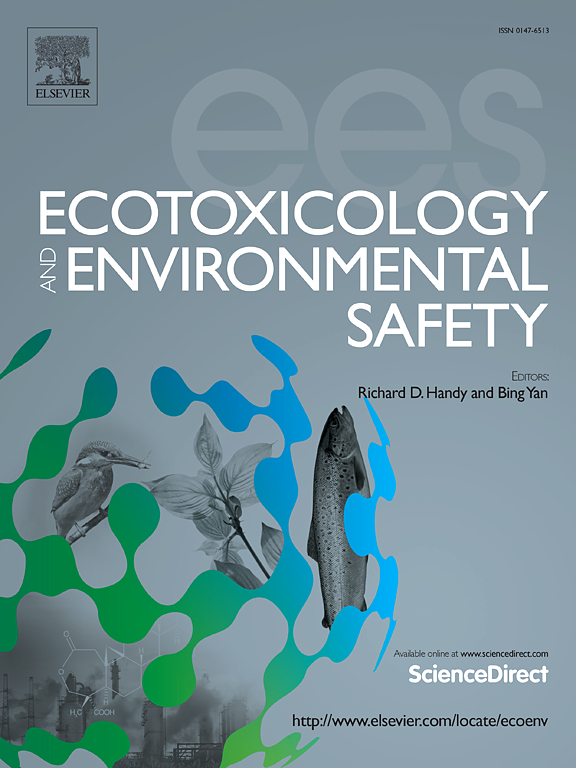镉和铅离子相互作用:用于食品安全风险评价的土壤复合重金属污染评估模型
IF 6.2
2区 环境科学与生态学
Q1 ENVIRONMENTAL SCIENCES
引用次数: 0
摘要
广泛的研究已经深入研究了与个别重金属有关的毒性和风险。虽然一些研究已经探讨了各种重金属的联合毒性,但仍然迫切需要建立评估重金属混合物联合污染与农业食品安全风险的协议。通过水培研究了镉(Cd(II))和铅(Pb(II))对小麦(Triticum aestivum L.)根系的联合毒性,并测定了20 Cd(II)-Pb(II)联合区间内的剂量依赖性相互作用行为。结果表明:当Cd(II)浓度为<; 0.002或0.021 ~ 0.061 mg/L时,Cd(II)与Pb(II)的相互作用主要为加性作用;当Cd(II)为0.002 ~ 0.021或>; 0.061 mg/L时,相互作用表现为显著的拮抗作用。基于植物生理特性,进一步建立了Cd(II)-Pb(II)复合污染下小麦Cd(II)生物积累模型(BCFCd模型)。利用最大和最小富集系数(Kmax和Kmin)定量分析了Pb(II)胁迫对小麦BCFCd的影响。将该模型应用于3种不同土壤类型,结果表明该模型在量化小麦对Cd(II)的根系吸收(R2 = 0.84)和籽粒吸收(R2 = 0.87)方面具有较好的效果。这些结果证实了BCFCd模型在土壤-小麦系统中应用的适用性。这个强大的预测工具在建立一个全面的框架来评估土壤环境中同时存在重金属污染的食品安全风险阈值方面显示出相当大的希望。本文章由计算机程序翻译,如有差异,请以英文原文为准。
Cadmium and lead ions interaction: A model for assessing combined heavy metal contamination in soils for food safety risk evaluation
Extensive research has delved into the toxicity and risks associated with individual heavy metals. While some studies have explored the combined toxicity of various heavy metals, there remains a pressing necessity to establish protocols for evaluating the combined contamination of heavy metal mixtures in relation to agricultural food safety risks. Here, we investigated the combined toxicity of cadmium (Cd(II)) and lead (Pb(II)) to Triticum aestivum L. roots by hydroponic culture, and determined dose-dependent interaction behaviors in 20 Cd(II)-Pb(II) combined intervals. The results showed that when Cd(II) concentration was < 0.002 or 0.021–0.061 mg/L, the main interaction between Cd(II) and Pb(II) was additive; and when Cd(II) was 0.002–0.021 or > 0.061 mg/L, the interaction was a significant antagonistic effect. We further established a Cd(II) bioaccumulation model (BCFCd model) of wheat under the Cd(II)-Pb(II) combined pollution based on plant physiological characteristics. The effect of Pb(II) stress on wheat BCFCd was quantitatively analyzed by the maximum and minimum enrichment coefficients (Kmax and Kmin). Application of the model to three distinct soil types demonstrated its robust performance in quantifying wheat root uptake (R2 = 0.84) and grain uptake (R2 = 0.87) of Cd(II). These results affirm the suitability of the BCFCd model for application within the context of the soil-wheat system. This robust predictive tool shows considerable promise in establishing a comprehensive framework for evaluating food safety risk thresholds in the context of concurrent heavy metal contamination in soil environments.
求助全文
通过发布文献求助,成功后即可免费获取论文全文。
去求助
来源期刊
CiteScore
12.10
自引率
5.90%
发文量
1234
审稿时长
88 days
期刊介绍:
Ecotoxicology and Environmental Safety is a multi-disciplinary journal that focuses on understanding the exposure and effects of environmental contamination on organisms including human health. The scope of the journal covers three main themes. The topics within these themes, indicated below, include (but are not limited to) the following: Ecotoxicology、Environmental Chemistry、Environmental Safety etc.

 求助内容:
求助内容: 应助结果提醒方式:
应助结果提醒方式:


